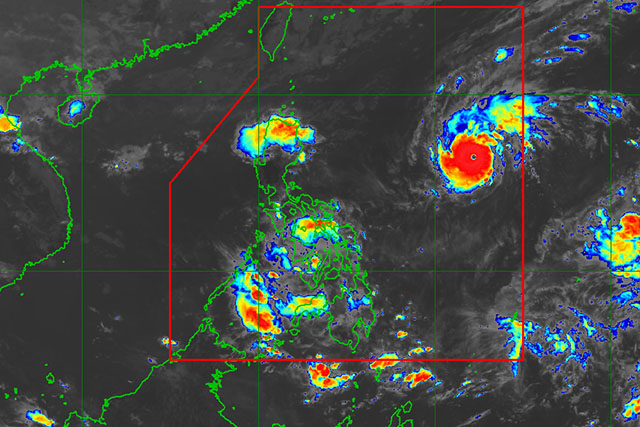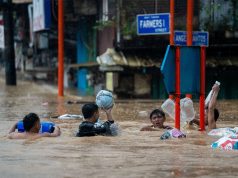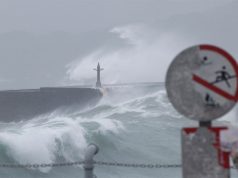
Two tropical cyclones are forecasted to consecutively enter the Philippine area of responsibility in the upcoming days until next week as the country greets the month of November.
An 11 a.m. advisory from state meteorologists indicates that Typhoon Rolly (international name Goni) would likely make a landfall over the Aurora-Quezon area on Sunday evening or Monday early morning with a peak intensity of 175-195 kilometers per hour (kph).
Its location as of 11 a.m. was 1,100 kilometers east of Central Luzon and its movement was reported to be 15 kilometers per hour westward. Its maximum sustained winds were recorded at 165 kph.
The Philippine Atmospheric, Geophysical and Astronomical Services Administration notes that Tropical Cyclone Wind Signal No. 1 may be raised over several provinces in the Bicol Region on Friday prior to the typhoon’s landfall.
The weather bureau added that the highest possible signals that will be raised throughout Rolly’s passage is Signal No. 3 or Signal No. 4.
Its morning advisory notes that the trough of the typhoon will bring light to moderate, with at times heavy, rains over Bicol Region, Visayas, Caraga, Northern Mindanao, and Zamboanga Peninsula.

It will also likely bring heavy to intense rains over Northern and Central Luzon and the Bicol Region beginning on Saturday or Sunday.
Typhoon Rolly is forecasted to be outside the Philippine area of responsibility on Tuesday morning. It is the 18th tropical cyclone that has entered PAR for this year.
RELATED: LIVE updates: Severe tropical storm Rolly
State meteorologists are also monitoring a tropical storm located outside PAR with the international name “Atsani” but it would likely enter on Sunday or Monday.
JTWC bumped up #Goni #RollyPH to reach 120 knot (CAT 4). I will not be surprised if it could reach CAT 5 super #typhoon over PHL Sea. This and TD 90W (pre-#Atsani #SionyPH) will become powerful twin typhoons in the next few days. November will be very busy for the #Philippines. pic.twitter.com/igg9y6kwUn
— Marvin Oloris (@marvinoloris) October 29, 2020
As of 10 a.m., its estimated location was 2,150 kilometers east of Mindanao.
The storm has maximum sustained winds of 65 kph near its center and has a gustiness of up to 80 kph.
It would be given the domestic name Siony once it enters the country but it is “less likely” to bring severe weather disturbance over the next three days, based on the available meteorological data.
Daylight on Rapidly Intensifying Typhoon Goni which may be Category 5 soon east of Philippines 🇵🇭
The Western Pacific has come to life with a flurry of Typhoons including another one just starting out 23W Atsani. 🌀 pic.twitter.com/N4B9KWrBbZ
— Ryan Maue (@RyanMaue) October 30, 2020
Meanwhile, Filipinos reminded each other to take safety precautions as they brace for the onslaught of the tropical cyclones.
“Pinas, dalawang bagyo matapos ang Quinta. Kapit!” a Twitter user said, referencing the previous typhoon that visited the country and lashed Southern Luzon after making five landfalls.
“OMG! Two strong typhoons coming! Pray, be safe, and be prepared, mahal kong Pilipinas,” another online user wrote in response to the reports of weather disturbance.
“Still reeling from the effects of #QuintaPH, my part of the #Philippines—an agricultural province—is bracing for at least two more typhoons expected to hit in the next week. Keep safe, everyone!” a Filipino likewise tweeted.
“#PrayforPhilippines #RollyPH and #SionyPH sana Lord humina man lang, mabilis paalis ng bansa, nagkaroon na kami phobia dahil sa ST (super typhoon) Lawin,” another Twitter user said, referencing the super typhoon that lashed at Luzon in 2016.
The Office of Civil Defense and the National Disaster Risk Reduction and Management Council advises Filipinos to do the following precautionary measures during a hazard amid a pandemic:
- Monitor weather updates from news sources on radio, television and the internet;
- Make sure to inspect houses and check for damage that needs to be repaired;
- Prepare a fully-stocked emergency “go bag” or a disaster kit that can be grabbed anytime;
- Save emergency numbers of relevant government agencies and local authorities in your area;
- Get to know the evacuation centers in your barangay;
- Remember to observe health and safety protocols for the coronavirus disease such as the wearing of face masks and face shields.









